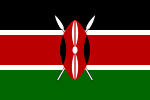| History of Kenya |
|---|
 |
|
|
| Part of a series on the |
| Culture of Kenya |
|---|
 |
| Cuisine |
The Sirikwa culture was the predominant Kenyan hinterland culture of the Pastoral Iron Age, c.2000 BP. Seen to have developed out of the Elmenteitan culture of the East African Pastoral Neolithic c.3300-1200 BP,[1] it was followed in much of its area by the Kalenjin, Maa, western and central Kenyan communities of the 18th and 19th centuries.
The archaeological evidence indicates that from about AD 1200, the Central Rift and Western Highlands of Kenya were relatively densely inhabited by a group (or groups) of people who practiced both cereal cultivation and pastoralism. They made occasional use of metals and created distinctive roulette-decorated pottery. These people are principally known from their characteristic settlement sites, commonly known as 'Sirikwa holes or hollows'. These comprise a shallow depression, sometimes reinforced at the edges by stone revetments, around which habitation structures were built. There are a number of indicators that the central depression was a semi-fortified cattle boma, with people living in connected huts around the exterior.[2]
The evidence suggests that this culture was fully formed in the central Rift Valley at least by 1300 A.D. From here it spread westward to Sotik and Nyanza province, northwards to Cherangani hills and then to Mt. Elgon area and possibly into Uganda.[3] This way of life would decline and eventually disappear by the 18th and 19th centuries.[4]
- ^ Lane, Paul J. (4 July 2013). Mitchell, Peter; Lane, Paul J (eds.). The Archaeology of Pastoralism and Stock-Keeping in East Africa. doi:10.1093/oxfordhb/9780199569885.001.0001. ISBN 9780199569885.
{{cite book}}:|journal=ignored (help) - ^ Lane, Paul J. (4 July 2013). Mitchell, Peter; Lane, Paul J (eds.). The Archaeology of Pastoralism and Stock-Keeping in East Africa. p. 728. doi:10.1093/oxfordhb/9780199569885.001.0001. ISBN 9780199569885.
{{cite book}}:|journal=ignored (help) - ^ Kyule, David M., 1989, Economy and subsistence of iron age Sirikwa Culture at Hyrax Hill, Nakuru: a zooarchaeological approach p.196
- ^ Kyule, David M., 1989, Economy and subsistence of iron age Sirikwa Culture at Hyrax Hill, Nakuru: a zooarchaeological approach pp.200–204